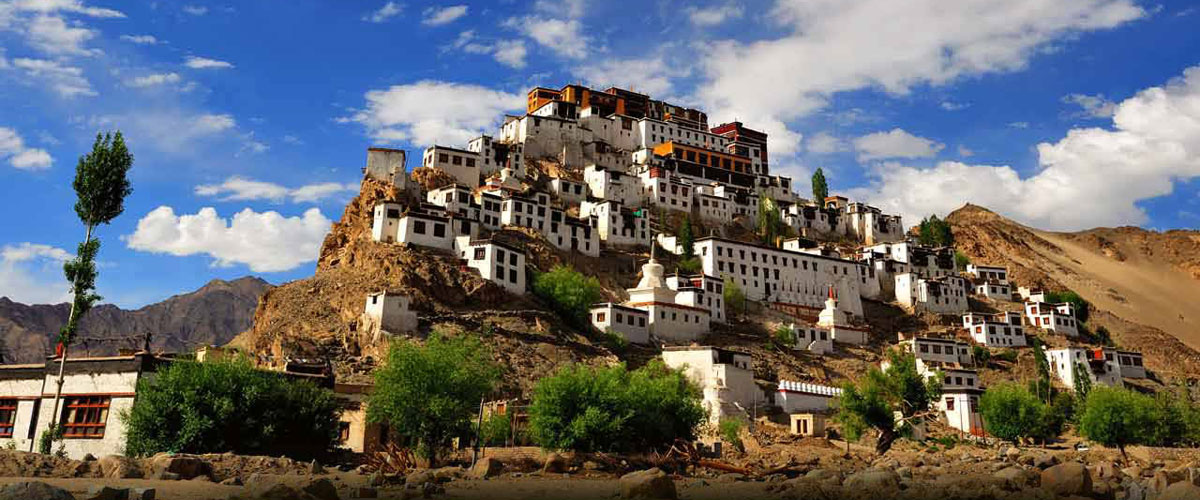
Information Ladakh
Desert in the Sky
Land of High Passes, Ladakh is a region located in the far north west of India in the state of Jammu and Kashmir. Straddling the crossroads of vital trade routes with central Asia, control over Ladakh changed hands between China and Tibet several times over the centuries. With a history punctuated by attempted conquests from neighbouring Muslim states, Ladakh aligned itself with Buddhist Tibet in religious matters and remains the subject of an ongoing territorial dispute between India, Pakistan and China to this day.
Rising up over 3000 meters and encompassing an area of 86,904 km2, the Ladakh Plateau lies in the so-called "rain shadow" of the Great Himalayas. Seldom penetrated by monsoon clouds, this barrier has made the region a high altitude desert renowned for its stark natural beauty and unparalleled panorama.
In Leh District, whose largest town bears the same name, culture and history are closely intertwined with those of Tibet with which it also shares borderlines to the east. Here the music of monastic festivals, the architecture, the cuisines and the elaborately embroidered local costumes all bear the unmistakeable influence of the heritage which Ladakh shares with its easterly neighbour.
Finally, a feature of Ladakhi society which sets it apart from an overwhelming majority of rural communities in India is the high status and relative emancipation enjoyed here by women.
The highlights of Ladakh are addictive - seeing the first simply adds to the anticipation of seeing them all.
ACCESS
The largest town in Ladakh is Leh whose airport is serviced by flights from Delhi. An overland approach by road is also possible via Kargil from approximately mid-June to mid-November.
TEMPERATURE
In summer it varies between 8C and 19C and in winter it ranges from -15C to -4C.
BEST TIME TO VISIT
From June to September, ideally in August
Land of High Passes, Ladakh is a region located in the far north west of India in the state of Jammu and Kashmir. Straddling the crossroads of vital trade routes with central Asia, control over Ladakh changed hands between China and Tibet several times over the centuries. With a history punctuated by attempted conquests from neighbouring Muslim states, Ladakh aligned itself with Buddhist Tibet in religious matters and remains the subject of an ongoing territorial dispute between India, Pakistan and China to this day.
Rising up over 3000 meters and encompassing an area of 86,904 km2, the Ladakh Plateau lies in the so-called "rain shadow" of the Great Himalayas. Seldom penetrated by monsoon clouds, this barrier has made the region a high altitude desert renowned for its stark natural beauty and unparalleled panorama.
In Leh District, whose largest town bears the same name, culture and history are closely intertwined with those of Tibet with which it also shares borderlines to the east. Here the music of monastic festivals, the architecture, the cuisines and the elaborately embroidered local costumes all bear the unmistakeable influence of the heritage which Ladakh shares with its easterly neighbour.
Finally, a feature of Ladakhi society which sets it apart from an overwhelming majority of rural communities in India is the high status and relative emancipation enjoyed here by women.
The highlights of Ladakh are addictive - seeing the first simply adds to the anticipation of seeing them all.
ACCESS
The largest town in Ladakh is Leh whose airport is serviced by flights from Delhi. An overland approach by road is also possible via Kargil from approximately mid-June to mid-November.
TEMPERATURE
In summer it varies between 8C and 19C and in winter it ranges from -15C to -4C.
BEST TIME TO VISIT
From June to September, ideally in August










